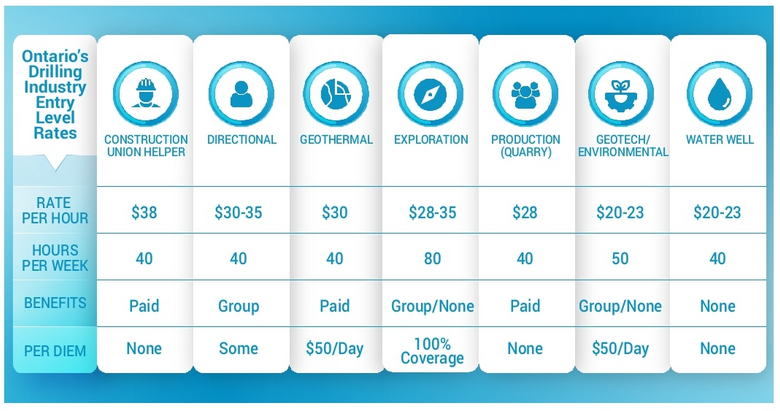
Features
News
Associations
Business
Drilling
Qualified but underpaid
April 29, 2021 By Sarah Eggleton, The Source
 Chart by Sarah Eggleton (for The Source); designed by Brooke Shaw, Annex Business Media
Chart by Sarah Eggleton (for The Source); designed by Brooke Shaw, Annex Business Media The drilling industry is booming! However, recent statistics tell us some divisions within the drilling industry are underpaid. Those entering the industry may have noticed, when job hunting for an entry-level position, that the water-well division of the industry is the lowest paid. Entry-level positions in the water-well division are a staggering 42.52 per cent lower than the average in the industry (see chart for details). Pay is crucial in obtaining and retaining qualified entry-level candidates in the water-well division.
A vast majority of candidates in the division are more qualified than most entry-level workers in the industry. Most entry-level candidates will have their post-secondary drilling and blasting two-year diploma, their DZ licence, their well technician licence, a crane operators certificate, only to name a few typical qualifications.
Are they a bargain hire? Are employers taking advantage of this discrepancy or is this a significant factor in the shortage of potential employees? Employers have increased the requirements for new hires, yet the rates have not increased to match the higher qualifications. Along with increased requirements, additional duties have been added to job descriptions with lowered titles and compensation.
With the cost of living increasing, and the debt1 assumed for qualifications for an entry-level water-well drilling position, it is becoming harder to find full-time, long-term employees at the current pay rate. The current pay rate or cost of a well has not increased with the general inflation rate of the “real world.” Current housing rates for a starter home range between $200,000 and $400,000, compared to 10 years ago. This has minimally tripled the amount of living costs. Without a pay reflection of the inflation increase, entry-level individuals will not be able to obtain a goal of purchasing their first home. With that said, at the current pay rate for entry-level positions, obtaining a mortgage of over $200,000 is impossible and unrealistic2. The division’s workers are struggling. The income inequality affects not only the ability to afford housing, but also the ability to save for retirement.
There has been an increase in housing prices of 82 per cent in urban areas and nearly 200 per cent in rural areas since 2010. With that being said, the inflation cost of drilling and installing a residential well has not increased.3 In 2010, the average cost of a residential well was between $7,000 and $10,000 for a $200,000 property/residence. And now in 2021 the average cost of a well installation for a $600,000 to $800,000 property is approximately $7,000 to $10,000. Residential well installation prices are not reflecting the inflation rate of the housing market, which in turn affects the economic well-being of the water-well division, its hard workers, and the ability of Well Contractors to pay properly.
This has to be the answer to why some employers in this division are not paying a living wage! Would a higher price for a residential well deter people from installing a well? Why does a septic system for the water to go to cost twice the cost of the water well which supplies it? What are the other options? Increasing the costs for a service is always tricky and best handled gradually in increments, but, If not achieved, it will remain detrimental to economic growth. Supply and demand working alongside the strict groundwater rules and regulations may leave the industry’s clients with no other choice but to accept the cost increase to an equitable level for a water well. Securing compensation for the real worth and importance of a quality water well is imperative to the longevity of the industry.
This division is at threat of losing out on the best talent and retention of qualified employees. This will surely add to increasing overhead costs in training, time and poorly completed jobs. The current state of the economy would seem to not make things any better; however, our industry hasn’t slowed down. Realistically, it is not the economy, it’s management. The lagging wages and reluctance of management to increase wages are reflective of the undervalued resource. Only management can reverse the trend that undervalues water wells, only management can sell the skills of their employees to the consumer. Only management can reverse the perception that workers are more of an expense than an investment. In a skill-driven economy and division, it is important to attract the most ambitious and passionate candidates. In the long run, they will be an appreciating asset contributing to the success and the performance of their employing company and the water well division of the drilling industry.
Accepting a lower-paying job is not the end of the world: making sacrifices to build and improve your job skills is essential in obtaining experience. It is tragic and substandard that water wells are so undervalued by the companies that build them.
Pay and sustain.
References
1 Ontario Student Assistance Program repayment calculator. https://osap.gov.on.ca/AidEstimator2021Web/enterapp/debt_calculator.xhtml#monthlypayment
2 Canada Mortgage and Housing homebuying calculators. https://www.cmhc-schl.gc.ca/en/consumers/home-buying/calculators
3 Canadian Real Estate Association National Price Map. https://www.crea.ca/housing-market-stats/national-price-map/
Sarah Eggleton is a staff member of Aardvark Drilling.
Print this page